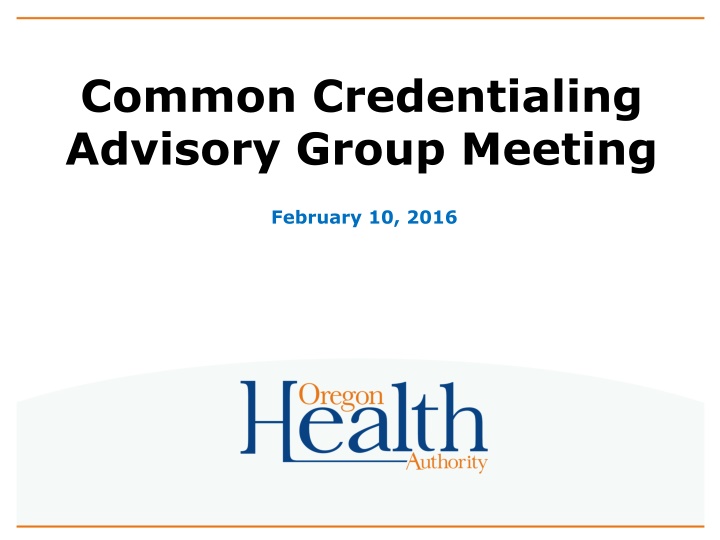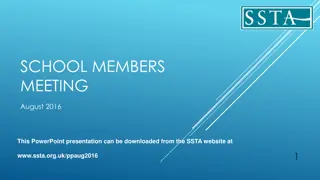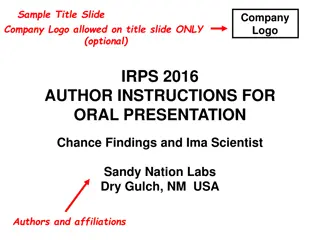
Credentialing Advisory Group Meeting Highlights - February 10, 2016
The Common Credentialing Advisory Group meeting on February 10, 2016, discussed updates on membership, procurement, charter, and Harris introduction. The meeting covered details on upcoming work, RAC fee development, and public testimony. Key topics included finalizing CCAG membership candidates, updating the charter to reflect current work, and introducing Harris's role in healthcare technology solutions. Harris, a technology innovator, aims to enhance interoperability, streamline workflows, and improve collaboration in healthcare. The meeting emphasized legislative requirements, project timelines, and feedback deadlines.
Download Presentation

Please find below an Image/Link to download the presentation.
The content on the website is provided AS IS for your information and personal use only. It may not be sold, licensed, or shared on other websites without obtaining consent from the author. If you encounter any issues during the download, it is possible that the publisher has removed the file from their server.
You are allowed to download the files provided on this website for personal or commercial use, subject to the condition that they are used lawfully. All files are the property of their respective owners.
The content on the website is provided AS IS for your information and personal use only. It may not be sold, licensed, or shared on other websites without obtaining consent from the author.
E N D
Presentation Transcript
Common Credentialing Advisory Group Meeting February 10, 2016
Agenda CCAG Membership and Charter Update Procurement Update and Harris Introduction Programmatic Details Upcoming Work Convening the RAC Fee Development Public Testimony
CCAG Membership Final candidates to represent: Hospitals Health Plans Independent Physician Associations (IPAs) Appointments to be approved by OHA Director Renewal of expiring memberships Revisit at the April CCAG meeting
Charter Update CCAG Charter updated to reflect current work Highlighting the Legislative Requirements SB 604: program, database, convene CCAG, develop rules, issue RFI, report to Legislature SB 594: establish implementation date with six months notice, report to Legislature High-level timeline through implementation Feedback and comment by February 19th
HARRIS INTRODUCTION AND HIT PORTFOLIO UPDATE GEORGE WEBBER: PROJECT MANAGER LEW PEARSON: TECHNICAL LEAD
Harris Overview Leading technology innovator, solving mission-critical challenges through advanced, technology-based solutions for government & commercial customers Founded in 1895 More than 22,000 employees, including 9,000 scientists and engineers Harris in Healthcare Entered domain in 2006 with vision of bringing data processing technologies used in defense areas to help solve challenges of health care, including: Increasing interoperability Making clinical and administrative workflow more efficient Strengthening collaboration across the continuum of care Areas of Expertise: Systems & Network Integration Clinical Research Support Cyber Security & Information Assurance Interoperability Harris became the prime contractor for the Oregon HIE (Health Information Exchange), branded as CareAccord CareAccord went live in May 2012 Offers statewide portal accounts for Direct Secure Messaging and its Provider Directory Managed Services Secure Infrastructure Health Records Sharing
HIT Portfolio Project Overview As the HIT Portfolio System Integrator (SI), Harris will provide Health Information Technology (HIT) Solutions and Services, including: Accountability for delivering HIT Portfolio Solutions Project and risk management Technical requirements, architectural roadmap and implementation design for the integration of HIT Solutions Systems integration ensuring interoperability of the HIT Solutions while maintaining privacy and security Prime contractor for best-vendor solutions (subs) and ongoing operations support Successful adoption of each HIT Solution (including outreach, change management and end user training) Integration of three new individual HIT Solutions: 1. Common Credentialing 2. Provider Directory 3. Clinical Quality Metrics Registry 8
HIT Portfolio Project Overview cont. Approach includes two distinct phases - Planning and Design - Implementation First Contract Amendment Planning and Design Phase Conducting the planning and design phase for Common Credentialing and Systems Integration requirements Tasks include: product evaluations securing a COTS product subcontractor for the CC solution procurement contracting interface and integration solutions common access solutions data management project management service 9
Critical Success Factors Overall critical success factors that OHA will use to measure the success of the HIT Portfolio and each of the implementation phases: Stakeholder engagement in HIT Solution selection process; HIT Solutions are implemented successfully on time and within budget; Project Deliverables meet or exceed the stated expectations of stakeholders as evidenced by system adoption; A Common Access Solution minimizes the effort for users to access solutions as evidenced by positive user feedback and reviews; and System interoperability Deliverables are met, as evidenced by efficiencies in data sharing and reductions in redundant data collection between and among State agencies and external stakeholders. Blue: Planning Phases Brown: Implementation Phases 10
Common Credentialing Project Summary Jan 2016 Feb 2016 Mar 2016 Apr 2016 May 2016 Jun 2016 Jul 2016 Dec 2016 Jan 2017 Dec 2017 - - - - - - - - - - Planning & Design Phase (6 Months) Implementation Phase (TBD Months) Requirements Definition CC Solution Architecture Design Vendor Selection 11
Technical Analysis - Introduction Enterprise Architect Modeling Tool World class modeling tool incorporating requirements, use case, workflow, and data modeling Modeling goals Incorporate all CC, SI (System Integration) requirements into the Model Map all requirements to Use Cases Sequence Use Cases into Workflows Generate Deliverables Technical Outputs Analysis is providing input for Requirements Traceability Matrix, Integration Requirements Specification, and Current & Future State Business and Technical Workflow Process These will be inputs for the Request For Proposal and Vendor Selection Process 13
Technical Analysis Progress Modeling Methodology Requirements Analysis Workflow Analysis Completion Criteria Requirements Analysis = Role + Use Case + Data Roles (users, systems, organizations) are determined by interviewing staff/SMEs and by analyzing requirements Each Role can execute different Use Cases Determine the interaction and conditional flow between Use Cases Determine the interaction, flow and responsibility between different Roles All requirements mapped to Use Cases All Use Cases mapped to Workflows Progress All CC and SI requirements are in the model Use Cases: 84 defined Use Cases, requirements being mapped Workflows: 11 defined Workflows, Use Cases being mapped 20+ Workflows to be entered into the Model 14
Provider Data Alignment OHA engaged stakeholders such as the Advisory Committee on Physician Credentialing, credentialing subject matter experts, and the Provider Directory Advisory Group Agreed on value of adding data elements to the common credentialing solution with some considerations: A handful of elements okay; but too many is not Do not add much in complexity or cost Minimizing provider burdens is important Could be a separate, but connected solution
OHAs Intent to Proceed Intend to explore cost and feasibility of including some of the additional data types via the RFP: Office hours/provider availability (per clinic affiliation) Accepting new patients (general and Medicare/Medicaid) Foreign languages (indication of written, spoken, or both) Assess vendor capabilities, cost, complexity Engage stakeholders on findings/recommendations In line with stakeholder advice/concern: Data are important, BUT Additional delay or extreme cost should be avoided
Delegation Agreements Existing process to create efficiencies Involves 3rd party information sharing DAs could impact the viability of the common credentialing solution and play a part in fee fluctuations Department of Justice Opinion: DAs not purposefully excluded from legislation Should allow practitioner credentialing information to be shared with delegating entities only if the practitioner allows it Rules should clarify instances in which entities which can enter into DAs to be consistent with telemedicine DA rules Subject matter expert opinions: Practitioners should know where their information may shared Third party sharing not necessary with OCCP Necessary to eliminate transactional fees
Credentialing Decision Informs practitioners of where they are credentialed Directs notifications to right credentialing organizations Department of Justice Opinion: Continued access to credentialing information after denial or termination violates confidentiality Application could indicate permission for release continues until such time as practitioner revokes authorization or identifies different entities as authorized recipients of the information Subject matter expert opinions: Must have a way for practitioners and credentialing organizations to discontinue relationships; not to be shared Record pull can indicate start of relationship Should create rule that practitioners and credentialing organizations must report discontinuances
Stakeholder Informed Options Delegation Agreement Options: 1. Do not track 2. Track delegation agreements, but not delegated practitioners 3. Track delegation agreements and workflow Credentialing Decision Options: 1. Track credentialing decisions 2. Allow the discontinuance of relationships
Intent to Proceed Delegation Agreements: Allow delegation agreements to extent efficient (roster scenario, quality control purposes) Third party information sharing not necessary Require reporting of delegation relationships, not delegated practitioners Add disclaimers that information may be shared via delegation arrangements as practitioner approved Credentialing Decision: Do not track decisions Allow discontinuances by practitioners and credentialing organizations Fee Structure: Replace transactional with annual subscription Rules must be developed to these intentions
Upcoming Work Convening the Rulemaking Advisory Committee Continued Fee Structure Development Marketing and Outreach Strategy Development Procurement activities (demonstrations)
More information can be found at: www.oregon.gov/oha/OHPR/occp












